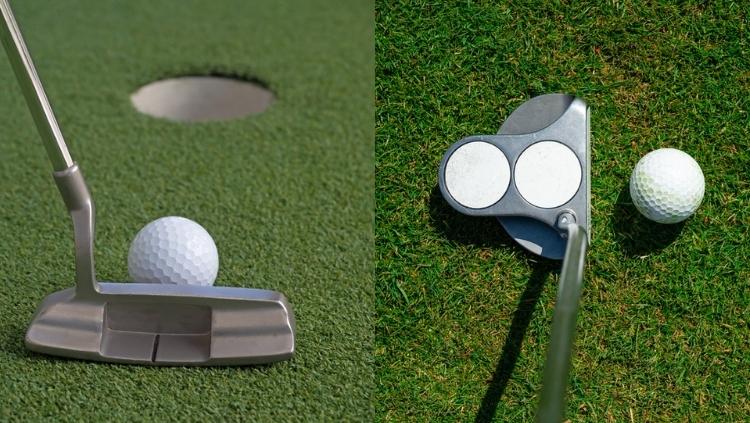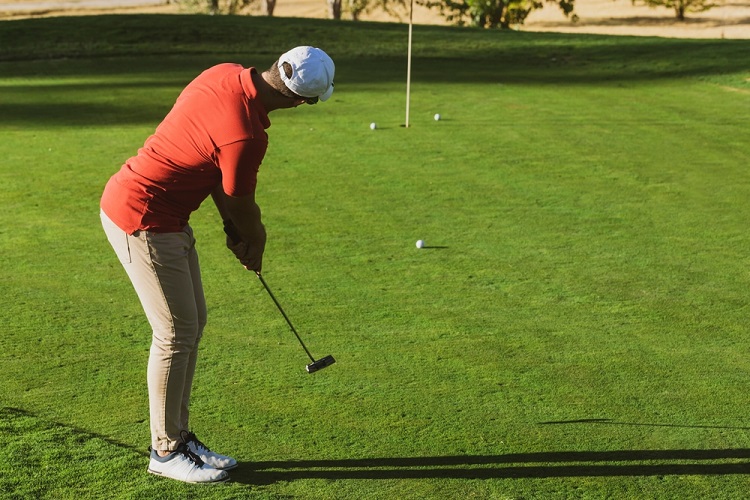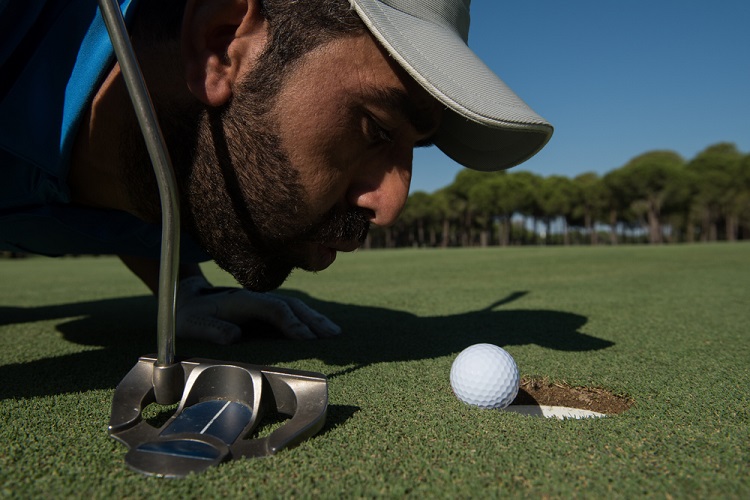In this guide on how to improve putting, we’ll offer actionable putting tips that can help you become a great putter and ultimately pave the way to lower scores.
Blade or Mallet

When it comes to putting, finding a flatstick that earns your confidence remains the most critical decision you can make.
In the world of putters, the putter head shape determines how you putt the golf ball.
A blade putter has a head that looks like the blade of a knife. The blade flatstick offers a lighter, sleeker feel with reduced weight. Players utilize an arcing stroke that moves inside to outside.
The alternative, the mallet putter, offers a bulkier head demanding a straight-back, straight-forward movement that emphasizes consistency and stillness.
Since each type of flatstick requires a different putting technique, you should find one that works best for you and provides the most consistency.
Reading a Green

Most golfers make the mistake of failing to read a green correctly during their time before a putt. PGA Tour players look at distance and tempo before choosing a putting line.
Just like you need to develop a pre-shot routine when hitting an iron, you need a pre-putt routine on the green that doesn’t slow down play but gets you on the correct line for your putt.
Starting behind the ball allows you to see any side to side tilt that determines how far out you need to start the putt.
Also, if you stand along the side of the putt and make a side to side survey of the green, you should be able to see any elevation changes that could slow down the speed of the putt as it reaches the hole.
You should make reading the green the focus of your pre-shot routine to help you relax. By removing tension from your putting, you’ll be able to quickly read the green and confidently strike your putts.
Pro Tip: A great way for amateurs to see the putt is to get closer to the cup and visualize how the ball will move over the final few feet to the hole. If you are struggling to get the ball inside three feet to the hole, get close to the hole, placing your feet wide on either side of the line and look at how the putt will enter the cup.
Check our complete guide on How to Read Greens in Golf: 5 Tips to Drain More Putts.
Speed Determines Distance

Probably one of the hardest parts of the golf game is reading putts. Not only do you have to determine putt speed, but you have to factor in the slope of the green.
Learning distance control on the putting green takes time, especially for weekend golfers that only play casually.
If you are looking to make more putts, the only way is through practice.
You need to seek out greens consisting of different grasses as the texture of the surface will ultimately determine break, speed, and the putting technique you need to sink more putts.
Pro Tip: In this simple putting drill, you need a few tees and a green with a slope leading to the hole. Take those tees around the green, find long putts from varying distances that will challenge you, and mark the starting point.
Before you putt at each tee, get behind the golf ball and make a horizontal read and a vertical one of the surface.
Visualize the break before you address the ball, getting a sense of distance and speed. Find the line and begin to make putts.
Each swing of the flatstick accounts for feel with your right hand since that guides the club through the golf ball and ultimately determines the final distance.
Avoiding Three Putts

Nothing can kill a scorecard like a three putt.
If you are unfamiliar, a “three-putt” means once you are on the green, it takes you three putts to get the golf ball into the hole.
The best putters on tour minimize their putting strokes per round, looking to get off the green in two putts or less. These players do that by mastering distance control by improving their lag putting.
Pro Tip: If you want to improve your lag putting, utilize this drill on the next trip to the practice green. You want to get golf balls inside three feet from the cup with your lag putts.
So take tees or even drop actual coins three feet from the cup in four different directions, making a circle you can visualize when lining up the putt.
In rounds of ten putts per session, see how many balls you can get inside the circle from 15, 20, 25, and 30 feet.
Be competitive with this drill and write down your score with each session, looking to improve your success over time.
How to Improve Putting FAQs
How do I get better at putting?
Practice on different surfaces to hone your stroke. Focus on your alignment and stance so they’re the same.
Use the “gate drill” to improve accuracy and control. Pay attention to the speed of your putts. Distance control is key.
Study the greens to understand the slopes and breaks so you can read putts better.
Why do I struggle with putting?
Struggling with putting is usually due to poor alignment, inconsistent strokes or difficulty reading greens.
Wrong grip pressure or stance can also hurt performance. Not focusing on speed control can also miss putts. Anxiety or lack of confidence can also hinder putting.
Targeted practice like alignment drills and visualization can help improve putting.
How do I aim better when putting?
To aim better, start by squaring up your putter face to the target. Use alignment aids on your putter or draw a line on your ball for help.
Visualize the ball’s path to the hole and adjust for slopes or breaks. Keep your eyes directly over the ball at address for a better perspective.
Consistency with these will help you get more accurate.
How do I get more confident with putting?
Practice regularly with focus on fundamentals like alignment and speed control.
Use drills to get consistent, like repeating short putts until they become automatic. Set achievable goals during practice to track progress.
Positive visualization of making putts and a relaxed grip will also reduce tension so you can approach each putt with confidence.
How can I improve poor putting?
When looking to improve your putting stroke, you should start small and then work your way to longer distances.
Most coaches teach students that the final three feet in front of a hole are the most important.
Along with making more short putts, players should work on hitting putts inside that three feet circle to save more pars and avoid making bogeys.
What is the secret to good putting?
Good putting is a combination of distance control and solid putting fundamentals.
There isn’t a perfect putter or perfect putting game technique for amateurs to adopt.
Instead, the best golfers utilize putters and techniques that give them the most confidence and produce the best results.
Must read: What is Aimpoint Putting?
Can you improve putting at home?
Yes, you can improve your putting at home. All you need is a mat or carpeted floor to get a consistent ball roll that allows you to work on creating a putting stroke you can take to the course.
Practicing putting drills from the comfort of your own home is a great way to increase your proficiency without spending many hours traveling to a golf course with a practice green.
We recommend you check our detailed guide: How to Choose a Putter
